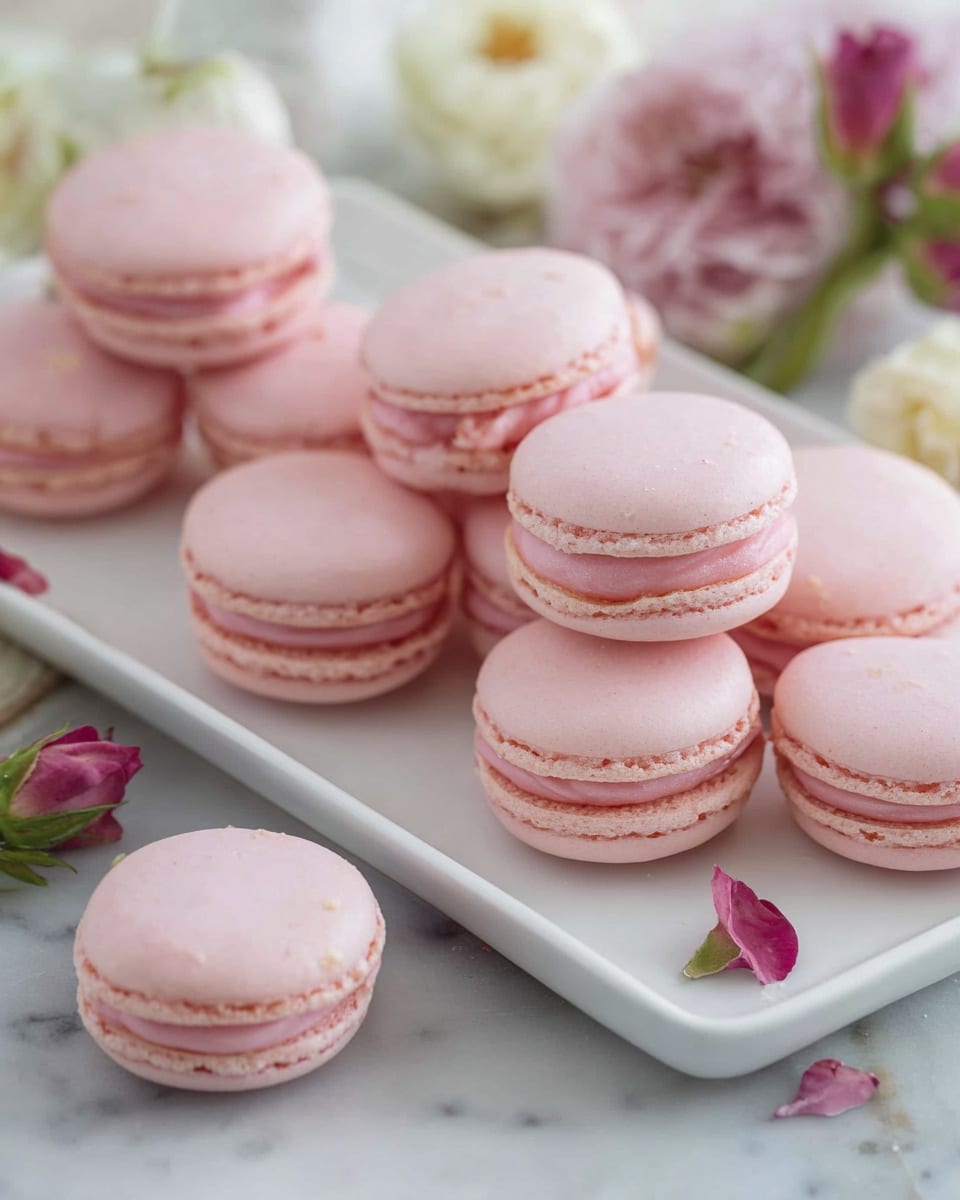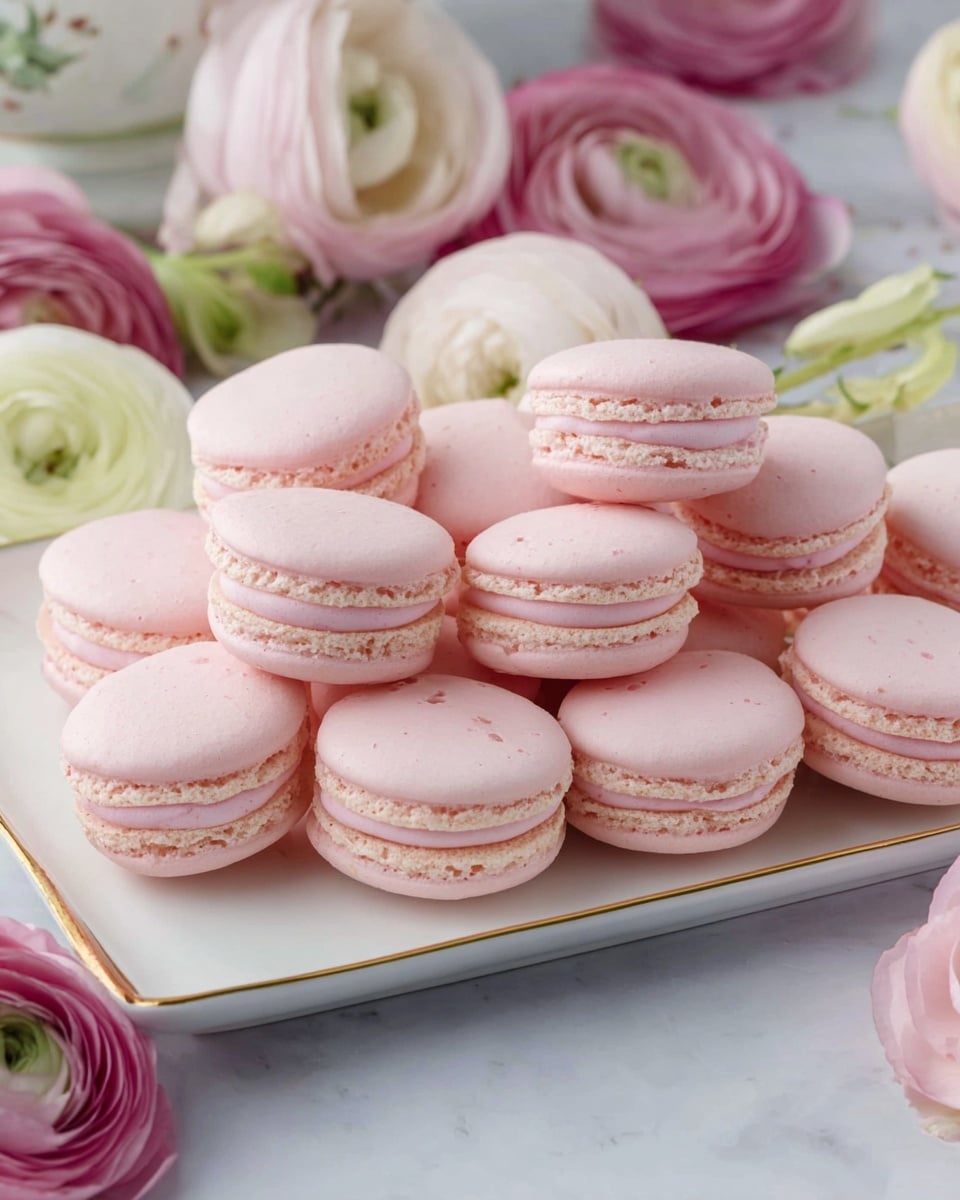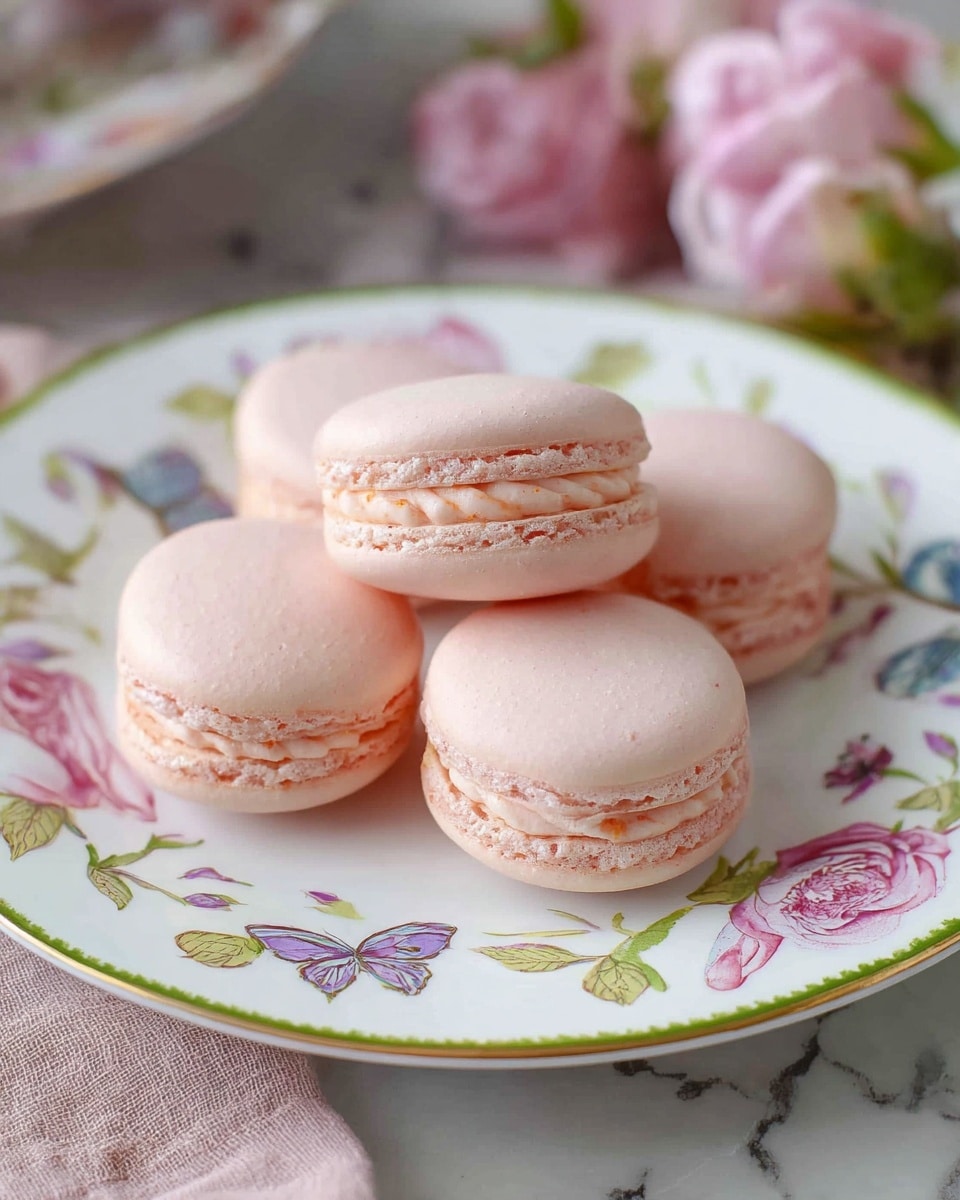If you’ve ever been intimidated by making macarons at home, I promise this French Almond Macarons with Buttercream Filling Recipe is going to change everything for you. I absolutely love how these delicate little treats turn out—crispy on the outside, chewy and tender inside, with a rich, creamy buttercream that’s simply irresistible. When I first tried my hand at macarons, I struggled, but this recipe is the one that finally made it click, and now I’m excited to share every detail so you can nail it on your first try. Trust me, your kitchen is about to become your new favorite dessert spot!
Why You’ll Love This Recipe
- Authentic Texture: This recipe achieves that perfect delicate crisp shell with a soft, chewy center every time.
- Creamy Buttercream Filling: Unlike simpler fillings, the French buttercream adds complexity and richness that makes these macarons truly special.
- Step-by-Step Ease: I break down every step to help you avoid common pitfalls, so you won’t feel overwhelmed.
- Perfect for Any Occasion: Whether it’s a celebratory afternoon tea or a gift, these macarons always impress.
Ingredients You’ll Need
The magic of these macarons starts with simple, high-quality ingredients. Each one plays a specific role in developing the texture and flavor that make this French Almond Macarons with Buttercream Filling Recipe shine. I always recommend using fresh almond flour and weighing everything – it really makes the difference.
- Egg whites: Room temperature egg whites whip better and help build that signature meringue structure you want for macarons.
- Almond flour: Use finely ground, blanched almond flour for the smoothest cookie surface and best texture.
- Granulated sugar: Adds sweetness and stabilizes the meringue when folded in slowly.
- Powdered sugar: Helps create that tender crumb and melt-in-your-mouth quality.
- Vanilla extract: A little natural flavor lift that blends beautifully in both cookie and filling.
- Cream of tartar: Stabilizes the egg whites so they maintain that stiff peak stage – critical for success.
- Unsalted butter: For the buttercream; softened butter is key for a smooth, creamy finish.
- Egg yolks: Integral for the French buttercream’s silky texture and richness.
- Water: Used for making the sugar syrup that transforms the buttercream into a luscious filling.
- Salt: Just a pinch to balance the sweetness and enhance flavors.
Variations
I love how adaptable this French Almond Macarons with Buttercream Filling Recipe can be—you can easily switch up flavors and colors to match your mood or occasion. Trust me, experimenting is part of the fun, and I encourage you to play around with different extracts and colors!
- Flavored Buttercream: I’ve tried swapping vanilla for rose water or lemon zest in the buttercream. Both options add a lovely twist that my friends can’t stop raving about.
- Colour Variations: Adding gel food coloring to the meringue lets you customize macarons for holidays or themed parties—just remember to add it after the meringue reaches soft peaks.
- Dietary Modifications: You can make the filling dairy-free by using a vegan butter substitute, although it changes the texture a bit—I suggest testing on a small batch first.
How to Make French Almond Macarons with Buttercream Filling Recipe
Step 1: Perfect the Meringue Base
Start by sifting your powdered sugar and almond flour together to get rid of lumps—you’ll want a silky smooth mixture so your macaron shells bake evenly. Then, whip room temperature egg whites in a spotless, grease-free bowl. When they begin foaming, add cream of tartar for stability and start slowly incorporating the granulated sugar. Keep beating until you reach stiff peaks, which means the meringue stands up firm and glossy when you pull out your whisk. This part took me the longest to get right, but once you see the meringue filling the whisk like a fluffy marshmallow, you’ll know you’re there!
Step 2: Folding in the Dry Ingredients
Gently fold one-third of your almond flour and powdered sugar mix into the meringue first—this lightens it up before you add the rest. It’s all about patience here! Carefully fold in the remaining dry ingredients, pressing the batter against the bowl to deflate just enough air. You’re aiming for a flowing “lava” consistency that falls off your spatula in thick ribbons without breaking. I discovered this technique after many attempts, and it really helps avoid flat or cracked macarons.
Step 3: Piping and Resting the Shells
Transfer your batter to a piping bag fitted with a round tip and pipe one-inch dollops onto parchment-lined baking sheets. I like to ‘glue’ the parchment to the tray with a few dabs of batter so it doesn’t shift—game changer! After piping, tap the tray sharply on the counter a few times to pop any trapped air bubbles, which cause unsightly holes. Then, let your shells rest for about 40 minutes to form a skin—this helps prevent cracking in the oven and ensures that beautiful glossy surface.
Step 4: Baking to Perfection
Bake your macarons at 300°F (150°C) for 12-15 minutes, but don’t forget to rotate your tray halfway through to ensure even baking. When done, they should lift off the parchment easily without sticking. Timing is crucial here; underbaked shells will be gummy, and overbaked ones too crisp. If you do overbake them by accident, I’ve found brushing a little milk on the bottom before assembling helps soften them back up beautifully.
Step 5: Crafting the French Buttercream Filling
Now for the star of the show—the rich, smooth buttercream. Start by heating sugar and water together until the sugar fully dissolves and then bring it to a boil until it reaches 240°F (115°C). Meanwhile, whisk your egg yolks in a stand mixer until pale and thick. With the mixer on low speed, slowly drizzle the hot sugar syrup into the yolks. Keep mixing until the mixture cools to room temperature—it thickens into a luscious base. Then you add softened butter one piece at a time, waiting for each to incorporate before adding the next. Finish off with vanilla and a pinch of salt for balanced richness. This step takes about 5-6 minutes but trust me, the silky creaminess is worth every second.
Step 6: Assemble and Age Your Macarons
Pipe the buttercream onto the back of half your cooled shells and sandwich with the remaining halves. Here’s a little insider trick: pop your filled macarons into the fridge for 1-3 days before serving. It sounds like a wait, but aging lets the flavors meld and softens the shells inside from the filling—making every bite pure bliss.
Pro Tips for Making French Almond Macarons with Buttercream Filling Recipe
- Perfecting the Meringue: I learned that whipping the egg whites just a bit beyond stiff peaks makes them marshmallowy—this is the stage you want for stability and shine.
- Sifting is Non-Negotiable: I always triple sift the almond flour and powdered sugar—discard bigger bits. You won’t regret the effort when your shells look silky smooth.
- Gentle Folding: Fold the batter like you’re handling a delicate secret—it should flow slowly off your spatula without breaking, like molten lava.
- Patience with Resting: Don’t skip the resting step before baking. It might feel like waiting forever, but it prevents cracks and makes those perfect glossy shells.
How to Serve French Almond Macarons with Buttercream Filling Recipe

Garnishes
I honestly love keeping these macarons classic with no extra garnish, letting their natural color and texture shine through. But for a little extra flair, I sometimes sprinkle a tiny dash of edible pearl dust or a few crushed almonds on top before baking; it adds subtle sparkle and crunch that gets compliments every time.
Side Dishes
They pair perfectly with a simple cup of Earl Grey tea or coffee—balancing the sweetness with a warm, comforting beverage. For a brunch spread, I like to serve macarons alongside fresh fruit and light cheeses for a colorful contrast.
Creative Ways to Present
When I’ve made these for special occasions, I love stacking them on a tiered dessert stand or placing them in pretty boxes with ribbons—looking fancy but easy to assemble. For parties, try colorful macarons arranged in a flower shape or spelling out a name for a personalized touch that always wowed my guests.
Make Ahead and Storage
Storing Leftovers
I keep my macarons in an airtight container in the fridge where they stay fresh and develop even better texture over 2-3 days. Just remember to bring them to room temperature before serving—that way the buttercream softens beautifully and the flavor comes alive.
Freezing
If I want to keep macarons longer, I freeze them unassembled, shell and filling separately, wrapped tightly in plastic. When ready, I thaw them in the fridge overnight and assemble just before serving. This approach keeps the shells crisp and the buttercream fresh.
Reheating
I avoid microwaving macarons—it can make them soggy fast. Instead, I like letting frozen or refrigerated macarons sit at room temp for about 30 minutes before enjoying. If the shells seem too firm, a quick brush of milk on the bottom before munching softens them just right.
FAQs
-
What’s the secret to getting smooth macaron shells?
The key is in thorough sifting of your almond flour and powdered sugar, combined with proper folding of the batter until it reaches a flowing lava consistency. Also, letting the piped shells rest so they form a skin before baking prevents cracks and promotes a smooth, shiny surface.
-
Can I make French Almond Macarons with Buttercream Filling Recipe without a stand mixer?
It’s possible, but a stand mixer with a whisk attachment makes whipping egg whites and buttercream much easier and more consistent. If you don’t have one, a handheld electric mixer works, but be prepared for a bit more arm work and slower results.
-
How do I know when the buttercream is ready?
When the buttercream is smooth, creamy, and holds soft peaks without being runny or grainy, it’s done. It should combine the cooked egg yolks and butter into a fluffy texture with a nice sheen.
-
Why do my macarons crack or have hollow shells?
Cracks usually happen if the shells haven’t rested long enough before baking or the oven temperature is too high. Hollow shells are typically a sign of overmixing the batter or baking for too long. Following the resting time and baking instructions precisely helps prevent these issues.
Final Thoughts
This French Almond Macarons with Buttercream Filling Recipe holds a special place in my kitchen adventures—once I cracked the code, I couldn’t stop making them. They’re like edible little rewards that show off your baking skills and wow your loved ones. I hope you enjoy every part of the process and fall as hard as I did for the delicate balance of chewy shells and smooth, indulgent buttercream. Give it a try soon—I’m rooting for you to bake the best batch you’ve ever had!
Print
French Almond Macarons with Buttercream Filling Recipe
- Prep Time: 15 minutes
- Cook Time: 25 minutes
- Total Time: 40 minutes
- Yield: 36 Macarons 1x
- Category: Dessert
- Method: Baking
- Cuisine: French
- Diet: Vegetarian
Description
This classic French macaron recipe features delicate almond meringue cookies sandwiched with a luscious French buttercream filling. Crisp on the outside and chewy on the inside, these pastel-colored treats are perfected through careful folding, precise baking, and a patient aging process to bring out their signature texture and flavor.
Ingredients
For the Cookie
- 100 g egg whites, room temperature (3 large eggs)
- 140 g almond flour (1 1/2 cups)
- 90 g granulated sugar (just under 1/2 cup)
- 130 g powdered sugar (1 cup)
- 1 tsp vanilla extract (5 mL)
- 1/4 tsp cream of tartar (800 mg)
For the Buttercream
- 1 cup unsalted butter, softened (226 g)
- 5 egg yolks
- 1/2 cup granulated sugar (100 g)
- 1 tsp vanilla extract
- 3 tbsp water (30 mL)
- 1 pinch salt
Instructions
- Prepare the Dry Ingredients: Sift the powdered sugar and almond flour together into a bowl to remove any lumps and larger pieces. For best results, sift multiple times and discard any large particles that remain.
- Whisk Egg Whites: In a very clean bowl, add the room temperature egg whites. Using an electric mixer, begin whisking until they start to foam. Add the cream of tartar and then slowly incorporate the granulated sugar while continuing to whisk. Beat until stiff, marshmallow-like peaks form.
- Add Flavor and Color: Mix in the vanilla extract and food coloring (optional) to the meringue once it reaches the soft peak stage, then continue beating until stiff peaks form.
- Fold Dry Ingredients: Begin folding in one-third of the dry ingredients into the meringue gently. Continue folding in the remaining dry ingredients carefully to avoid deflating the meringue. The final batter should have a thick lava-like consistency, flowing slowly and capable of falling in a figure eight without breaking.
- Pipe Macarons: Transfer the batter to a piping bag fitted with a medium round tip. Pipe one-inch dollops onto a baking sheet lined with parchment paper that’s secured with a few dabs of batter. Tap the tray on the countertop to release air bubbles and allow the piped batter to rest for about 40 minutes until a dry, smooth skin forms on top.
- Bake Shells: Preheat the oven to 300°F (150°C). Bake the macaron shells for 12-15 minutes, rotating the tray halfway through after about 7 minutes to ensure even baking. Allow shells to cool completely before removing from the baking sheet.
- Prepare Sugar Syrup: In a medium saucepan, combine the granulated sugar and water. Stir over low heat until the sugar dissolves, then increase the heat to medium-high and boil until the syrup reaches 240°F (115°C) on a candy thermometer.
- Whisk Egg Yolks: Meanwhile, place the egg yolks in a stand mixer fitted with a whisk attachment. Beat until thick and foamy.
- Combine Syrup and Yolks: With the mixer running, slowly drizzle the hot sugar syrup into the egg yolks. Continue mixing until the mixture cools to room temperature and the bottom of the bowl feels cool to the touch.
- Add Butter and Flavor: Incorporate the softened butter into the cooled yolk mixture one cube at a time, fully beating each piece in before adding the next. Add vanilla extract and a pinch of salt, then beat the buttercream until smooth and creamy, about 5-6 minutes. Add food coloring if desired.
- Assemble Macarons: Pipe the buttercream filling onto the back of half the macaron shells. Sandwich with the remaining shells. For best results, refrigerate the filled macarons for 1 to 3 days to allow the filling to soften the shells and develop flavor.
Notes
- The meringue must be whipped to stiff, marshmallowy peaks—this is crucial for macaron texture.
- Always sift almond flour and powdered sugar thoroughly to prevent lumps that affect shell appearance.
- Use a scale to measure ingredients accurately for consistent results.
- Fold batter gently but thoroughly to reach the correct lava-like consistency without deflating the meringue.
- Pipe macarons straight down perpendicular to the baking sheet to maintain round shape.
- Add food coloring after reaching soft peaks for even color.
- After piping, allow shells to rest for 40 minutes to form a skin that helps prevent cracking.
- Macarons are best enjoyed after resting in the fridge for 2-3 days to develop optimal texture and flavor.
- If shells become overly crisp after baking, brushing the bottoms with a little milk before assembling can soften them.
Nutrition
- Serving Size: 1 macaron
- Calories: 85
- Sugar: 8 g
- Sodium: 15 mg
- Fat: 5 g
- Saturated Fat: 3 g
- Unsaturated Fat: 2 g
- Trans Fat: 0 g
- Carbohydrates: 9 g
- Fiber: 0.5 g
- Protein: 1.5 g
- Cholesterol: 20 mg




Your email address will not be published. Required fields are marked *